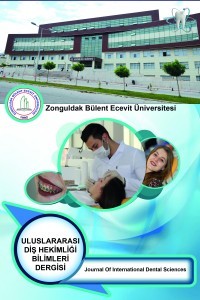ÖN ISITMA İŞLEMİNİN SÜT DİŞİ KÖK KANAL PATININ AKIŞKANLIĞI ÜZERİNE ETKİSİ
Akışkanlık, Kanal tedavisi, Ön Isıtma, Süt Dişi
THE EFFECT OF PREHEATING ON THE FLUIDITY OF PRIMARY TEETH ROOT CANAL SEALER
Fluidity, root canal treatmeant, preheating, primary tooth,
___
- Referans1. Alaçam A. Pedodontide endodontik yaklaşımlar. 2 ed. Ankara: Barış Yayınları, Özyurt Matbaacılık; 2012.
- Referans2. Retrospective analysis of primary teeth extractions - C Burdurlu, V Dagasan, F Cabbar, C Karakurt, B Atalay - Yeditepe Dental Journal, 2020
- Referans3. McDonald, Ralph E., and David R. Avery. "Development and morphology of the primary teeth." McDonald and Avery Dentistry for the Child and Adolescent-E-Book (2010): 41.
- Referans4. Çetinkaya, İrem, and Emre Bodrumlu. "Üç farklı sıcaklıktaki iki farklı kök kanal patının akıcılık özelliğinin değerlendirilmesi." Atatürk Üniversitesi Diş Hekimliği Fakültesi Dergisi 29.1: 7-11.
- Referans5. Nadkarni U, Damle SG. Comparative evaluation of calcium hydroxide and zinc oxide eugenol as root canal filling materials for primary molars: a clinical and radiographic study. J Indian Soc Pedod Prev Dent 2000;18(1):1-10
- Referans6. Nurko C, Ranly DM, García-Godoy F, Lakshmyya KN. Resorption of a calcium hydroxide/iodoform paste (Vitapex) in root canal therapy for primary teeth: a case report. Pediatr Dent. 2000 Nov-Dec;22(6):517-20. PMID: 11132515.
- Referans7. Chang, Seok Woo, et al. "Comparison of the rheological properties of four root canal sealers." International journal of oral science 7.1 (2015): 56-61.
- Referans8. Balguerie, Eric, et al. "Sealer penetration and adaptation in the dentinal tubules: a scanning electron microscopic study." Journal of endodontics 37.11 (2011): 1576-1579.
- Referans9. Prabhakar AR, Yavagal C, Vallu RK. Twisted vs protaper files in contemporary pediatric endodontics. Int J Clin Pediatr Dent 2014;7(2): 93-6.
- Referans10. Silva LA, Leonardo MR, Nelson-Filho P, Tanomaru JM. Comparison of rotary and man- al instrumentation techniques on cleaning capacity and instrumentation time in deciduous molars. J Dent Child (Chic) 2004; 71:45-7.
- Referans11. Ahmed, H. M. A., et al. "A new system for classifying root and root canal morphology." International endodontic journal 50.8 (2017): 761-770.
- Referans12. Daronch M, Rueggeberg FA, De Goes MF. Monomer conversion of pre-heated composite. J Dent Res. 2005;84(7):663
- Referans13. Madhuri GV, Varri S, Bolla N, Mandava P, Akkala LS, Shaik J. Comparison of bond strength of different endodontic sealers to root dentin: An in vitro push-out test. J Conserv Dent. 2016;19(5):461-464. doi:10.4103/0972-0707.190012
- Referans14. Pecora JD, Ribeiro RG,Guerisoli DMZ, Barbizam JVB, Marchesan MA. (2002). Influence of spatulation of two zinc-oxide-eugenol-based sealers on the obturation of lateral canals. Pesqui Odontol Bras, 16(2):127-130.
- Referans15. Lim E-S, Park Y-B, Kwon Y-S, Shon W-J, Lee K-W, Min K-S. Physical properties and biocompatibility of an injectable calcium-silicate-based root canal sealer: in vitro and in vivo study. BMC Oral Health 2015;15:129.
- Referans16. Silva EJ, Rosa TP, Herrera DR, Jacinto RC, Gomes BP, Zaia AA. Evaluation of cytotoxicity and physicochemical properties of calcium silicate-based endodontic sealer MTA Fillapex. J Endod. 2013 Feb;39(2):274-7. doi: 10.1016/j.joen.2012.06.030. Epub 2012 Aug 9. PMID: 23321245.
- Referans17. Lee JK, Kwak SW, Ha JH, Lee W, Kim HC. Physicochemical Properties of Epoxy Resin-Based and Bioceramic-Based Root Canal Sealers. Bioinorg Chem Appl. 2017;2017:258284
- Referans18. Viapiana R, Flumignan DL, Guerreiro-Tanomaru JM, Camilleri J, TanomaruFilho M. Physicochemical and mechanical properties of zirconium oxide and niobium oxide modified Portland cement-based experimental endodontic sealers. Int Endod J. 2014;47(5):437-48.
- Referans19. Knight JS, Fraughn R, Norrington D. Effect of temperature on the flow properties of resin composite. Gen Dent. 2006;54(1):14-6.
- Referans20. Broome JC. Effects of preheating resin composite on flowability. The Dental Advisor. 2006;4(1): 4-9.
- Referans21. Marcondes RL, Lima VP, Barbon FJ, Isolan CP, Carvalho MA, Salvador MV, Lima AF, Moraes RR. Viscosity and thermal kinetics of 10 preheated restorative resin composites and effect of ultrasound energy on film thickness. Dent Mater. 2020;36(10):1356-64.
- Referans22. Al-Ahdal K, Silikas N, Watts DC. Rheological properties of resin composites according to variations in composition and temperature. Dent Mater. 2014;30(5):517-24.
- Referans23. Lacey, S., et al. "The effect of temperature on viscosity of root canal sealers." International endodontic journal 39.11 (2006): 860-866.
- Referans24. Chang, Seok Woo et al. “Comparison of the rheological properties of four root canal sealers.” International journal of oral science vol. 7,1 56-61. 23 Mar. 2015, doi:10.1038/ijos.2014.33
- Referans25. Yamauchi, Shinya, Satoshi Watanabe, and Takashi Okiji. "Effects of heating on the physical properties of premixed calcium silicate-based root canal sealers." Journal of Oral Science (2020): 20-0325.
- Referans26. Çınar, Hande, and Semra Sevimay. "Farklı içerikli kök kanal dolgu patlarının reolojik özelliklerinin incelenmesi."
- ISSN: 2149-8628
- Yayın Aralığı: Yılda 3 Sayı
- Yayıncı: Zonguldak Bülent Ecevit Üniversitesi
Endodonti-Ortodonti Arayüzü: Endodontik Tedavi, Ortodontik Kuvvet ve Dental Pulpa İlişkisi
Büşra DEMİR ÇİÇEK, Orhan ÇİÇEK
TAM DİŞSİZLİĞİN MODİFİYE HİBRİT PROTEZLER İLE RESTORASYONU: OLGU SUNUMU
Ayşegül KÖROĞLU, Seda CENGİZ, Özge SUCU, Şükriye Ece GEDUK
65 yaş ve üstü hastaların sistemik durumlarının değerlendirilmesi
A.pinar SUMER, Mahmut SÜMER, Mesude ÇİTİR, F.zehra BODUR, Günay GÜRAY, Soner ÇANKAYA
FARKLI TUTUCU SİSTEMLERİNE SAHİP İMPLANT DESTEKLİ PARMAK PROTEZLERİ: 4 OLGU SUNUMU
Seçil KARAKOCA NEMLİ, Bilge TURHAN BAL, Merve BANKOĞLU GÜNGÖR, Ceyda Başak İNAL
ÖN ISITMA İŞLEMİNİN SÜT DİŞİ KÖK KANAL PATININ AKIŞKANLIĞI ÜZERİNE ETKİSİ
Ebru HAZAR BODRUMLU, Seda Nur DEMİR
Fatih EROL, Ecehan HAZAR, Murat KOCAK, Sibel TAZEGÜL-KOCAK, Baran Can SAĞLAM
